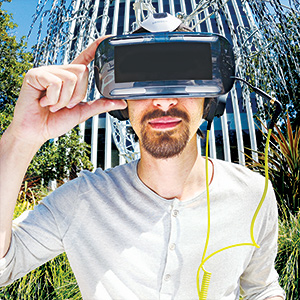

One moment I’m rock climbing in the rust orange Utah desert. The next I’m soaring over the surrounding landscape as my companions leap from the top of a craggily spire. Looking over my shoulder, I can see them pull their chutes after several seconds of freefall.
Not long after, I am in a much darker place—strapped to a chair in a warehouse of horrors. I hear a noise behind me and I twist around to see a young girl. “Isn’t this place great?” she asks, with a laugh that is at once childish and sinister. A bag is thrown over my head.
“All right,” the woman behind the computer says, as I rip the bulky goggles off my face. It seems she has sensed my distress, and she assures me that the three minutes I just spent in that spooky scene is about all most people can handle. “Unless you’re a real horror fanatic.”
She’s got a point. Even though I knew I wasn’t actually in an industrial torture chamber, surrounded by cloaked figures and a demented little girl, the experience was convincing enough to be unsettling. It certainly didn’t help that I couldn’t look away, as the screen—strapped just inches from my eyes—followed my gaze wherever I turned.
At this moment I am actually in Palo Alto, at the headquarters of Jaunt VR—experiencing the current reality of virtual reality. Unlike the clunky polygons of Lawnmower Man and the extremely limited VR games that once populated ’90s-era arcades, today’s virtual reality promises to be a legitimate form of entertainment in the very near future. It is an immersive experience that can put you in the front row seat of a Big Sean concert, fly you over Arches National Park, or plunge you into the middle of a nightmare—no matter where you are in the real world.
Virtual reality is coming to a face near you. For real this time.
Long Promised
Back in 1995, four years before Neo decided to take the red pill, Keanu Reeves played the titular character in Johnny Mnemonic—a cyberpunk action-thriller based on the William Gibson book of the same name. Watching the film today, it’s hard not to chortle. The virtual world Reeves’ character navigates looks like it was created by a high school student in an introductory computer animation class.
Mnemonic was set in the year 2021. But consumers won’t have to wait six more years to access terrible VR. In fact, there are plenty of rather convincing experiences available now. And many of the people creating these experiences are working right in our backyard—from large companies forging partnerships with Hollywood, like Jaunt, to small entrepreneurs making VR films on a tighter budget, like Redwood City’s Mind VR.
Granted, virtual reality has yet to reach the level of a widely available consumer product. But the bulk of the technology to bring VR to the masses is already here—tucked away in our pockets and purses.
According to Scott Broock, VP of content for Jaunt, people will soon be accessing virtual reality videos and games wirelessly—simply by plugging their phones into specialized headsets. In fact, some of these accessories are already available. They range in price from about $200 for the Samsung-specific Gear VR headset down to the neighborhood of $5 for what’s known as “Google Cardboard”—quite literally a cardboard headset that a user assembles himself and then slides his phone into.
Not only is much of the technology to view VR films and games readily available to consumers, developers all over Silicon Valley are feverishly working to create virtual reality cameras and editing software that will eventually put the creation of projects within reach of professional filmmakers and hobbyists alike.
Jaunt’s ball-shaped VR camera resembles those orbs mounted atop Google’s fleet of Street View cars. They’ve used the cameras to capture footage of a Paul McCartney’s final concert at Candlestick Park. Jaunt’s software stitches the multiple viewpoints into a cohesive, 3D sphere that envelops the viewer. Watching the completed video, I am standing right next to McCartney as he plays a grand piano. I contemplate Sir Paul for a moment, then turn my attention to the crowd. Jaunt has also mounted its camera on a drone, which they used to capture the footage of base jumpers in Utah.
Mind VR also has a proprietary camera, which they have used to create a number of music videos. Guy and Sue Coggins, the married couple at the helm of the Redwood City-based company, visited the Metro offices to show off their work. Their muse: the former pimp extraordinaire and long-time blues musician, Fillmore Slim.
Strapping on the their Oculus headset, I am transported to a Fillmore Slim concert at The Oasis on Treasure Island. I turn my attention from Slim to his bassist and and then, once again, to crowd—which is filled with many lavishly dressed men and women. “We thought it was a costume party,” Guy says, with a sheepish grin. “It turned out they were real pimps.”
The growing number of developers picking up the gauntlet of virtual reality is a good sign for the nascent industry. The more people creating hardware and applications for VR, the sooner one of them is likely to capture the public’s attention at an affordable price point.
So just what will VR’s killer app be, and why should you care?



